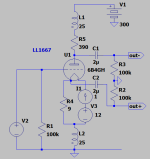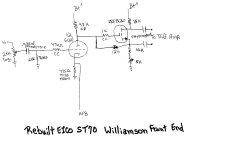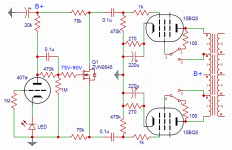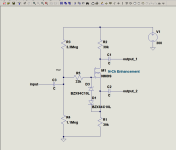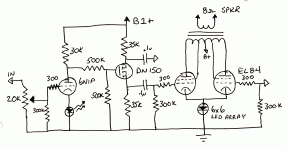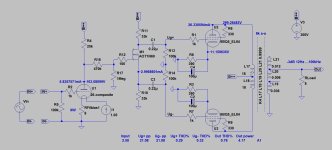Build something like this below and forget 26, input transformers etc. etc.I'd like to know what are the choices for a phase splitter on the input of a PP amp so it could be driven by a preamp with gain using RCA inputs. Amp in question is an EL84 in PPP triode, so 8 output tubes in all. Choices I can think of include....
- input transformer like 1:1+1 or 1:2+2
- solid state splitter
- valve concertina without the gain stage in front
- ??? something else
I'd like something simple and transparent that could be driven with a 26 DHT preamp in this case, but this is a universal application so feel free to talk around choices as much as you would like.
https://diyaudioprojects.com/Schema...-6V6-6AQ5-Dynaco-A-410-Tube-Amp-Schematic.htm
I have done a similar one with the PCL82's and it just sounds glorious. Makes wonder why one should waste more money in 45's, other DHT's, transformers, preamps etc...
A conventional EL84 PP amp with feedback isn't in my plans, though I agree they can sound very nice. I'm very happy with my "Inverted DHT" amps - single ended 2 stage with 26 driving high gain output tubes like the EL12.
I just have a PP chassis which I'm wondering what to do with. I might use it to drive a pair of bass units with an active crossover, for instance. Just speculation at this stage. But my preference would be to use my 26 stage. I could build myself a new preamp stage with e.g. 4P1L into a LL1660 which would do the phase splitting. But I would prefer to put the phase splitter in the amp.
I just have a PP chassis which I'm wondering what to do with. I might use it to drive a pair of bass units with an active crossover, for instance. Just speculation at this stage. But my preference would be to use my 26 stage. I could build myself a new preamp stage with e.g. 4P1L into a LL1660 which would do the phase splitting. But I would prefer to put the phase splitter in the amp.
It's not conventional at all the way it sounds and measure. I only use 6 db fbk. LL1682 is a great OPT for PCL82 PP.
Nice to hear this "simple" schematic sounds so well. Do you have an idea why it is so good? The current of the driver tubes is returned to ground through the OPT, first time I noticed that.Build something like this below and forget 26, input transformers etc. etc.
https://diyaudioprojects.com/Schema...-6V6-6AQ5-Dynaco-A-410-Tube-Amp-Schematic.htm
I have done a similar one with the PCL82's and it just sounds glorious. Makes wonder why one should waste more money in 45's, other DHT's, transformers, preamps etc...
Sorry for the odd topic, OTOH I know Andy is open minded to accept that 🙂
I would go for your suggestion but with an added gyrator on top of the 26.Why not use parafeed CT choke driving?
I have not used exactly that circuit but it's not much different except the "detail" you mention. Mine is a more conventional paraphase +UL and 6 dB feedback. IMHO, the paraphase makes it sound better and more SE-like, despite it is regarded less ideal than others. Overall distortion is still PP-like and very low. With 300V supply + LL1682 it makes 12W before you notice little flattening of the sinusoid on the scope.Nice to hear this "simple" schematic sounds so well. Do you have an idea why it is so good? The current of the driver tubes is returned to ground through the OPT, first time I noticed that.
Sorry for the odd topic, OTOH I know Andy is open minded to accept that 🙂
1:1 transformer is my vote. simple not expensive and works well. If you use 1:2 the pre needs to drive more C and I don't think current drive is a strength of the 26
Could be worth a try. Why not DC-coupled to the anode of the 26 to eliminate the voltage divider and coupling cap? Anode voltage of the 26?Can you just use a single mosfet for an input splitter?
This is with with 100V bias and sims great.
Last edited:
Voltage on anode of 26 would be somewhere around 120-140V with B+ from 320 to 360V. You'd then have XLR balanced out and 2 coupling caps. I have XLR inputs on the amp as well as RCA.
Thanks for that. But could you put the voltages on your schematic please? 26 anode and top and bottom of mosfet?Could be worth a try. Why not DC-coupled to the anode of the 26 to eliminate the voltage divider and coupling cap? Anode voltage of the 26?
This is with with 100V bias and sims great.
How do you calculate the design? Do you leave the Va and B+ of the valve stage as they are and let the voltages in the Mosfet just find their natural level? Or is the Va of the valve stage critical? If you used a voltage divider in front what would determine the voltage of that, say in relation to 300V?
Presumably you choose the resistor value for the current you want - in your design 6mA.
Presumably you choose the resistor value for the current you want - in your design 6mA.
DN2540 works well at 5-6mA. When you know the drivers Ua you can calculate Rk. Ra must be the same, ie you have to select B+ to get enough voltage over the depletion mosfet.
Wouldn´t go for a voltage divider with AC input, would do it like this instead:

Wouldn´t go for a voltage divider with AC input, would do it like this instead:
Last edited:
Last edited:
If you really want to do something different why not use another 26 as concertina? A DHT doesn't even have the cathode-to-heater voltage limit of a IHDT....
Do you have an idea why is the DN2540 is so bad? Capacitances?FET phase splitter sample based on the above.
View attachment 1286185
p.s.
DN2540 almost unusable as next VAS (or in this case splitter) stage with high output impedance tubes as #26. It's HF behaviour is horrible, even over 10k the falling begins.
Remember the concertina has heavy NFB, like a source follower with two outputs. When adding your, in my view unnecessary voltage divider it might be, but with 8k directly from a 26 you reach -3dB at over 350kHz. With 50k you will only reach ca 70kHz.DN2540 almost unusable as next VAS (or in this case splitter) stage with high output impedance tubes as #26. It's HF behaviour is horrible, even over 10k the falling begins.
Not familiar with the one you use, how much lower capacitance has it got?
- Home
- Amplifiers
- Tubes / Valves
- Phase splitter choices on input of PP amp
